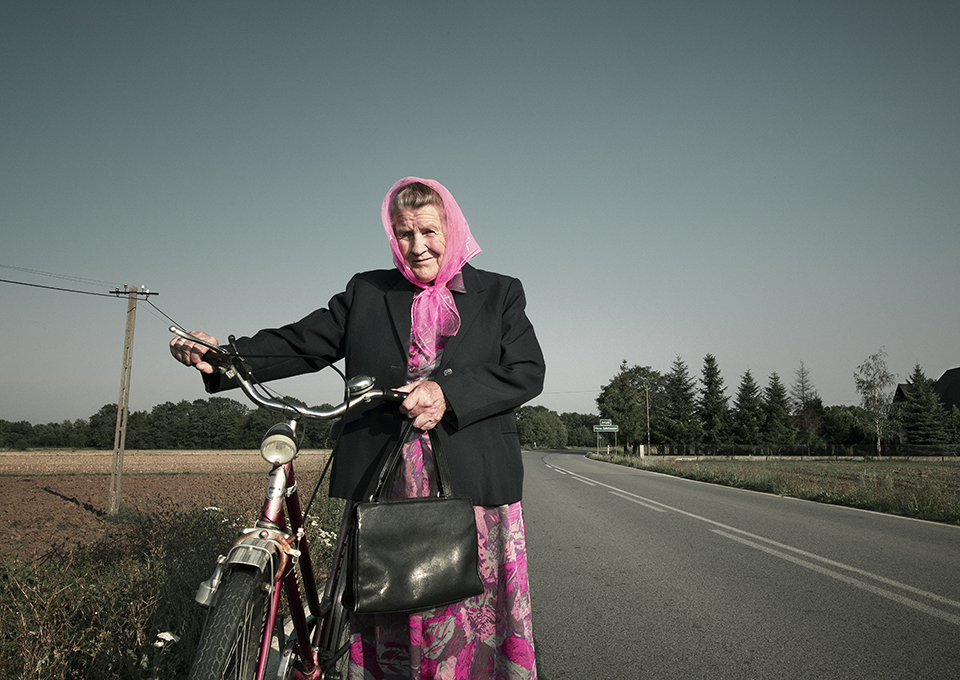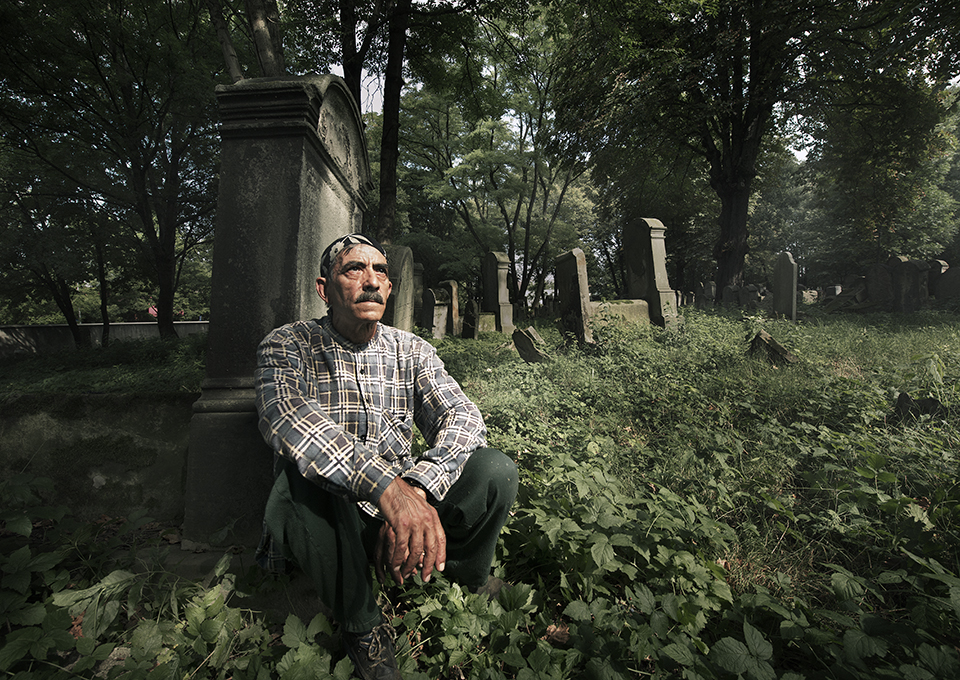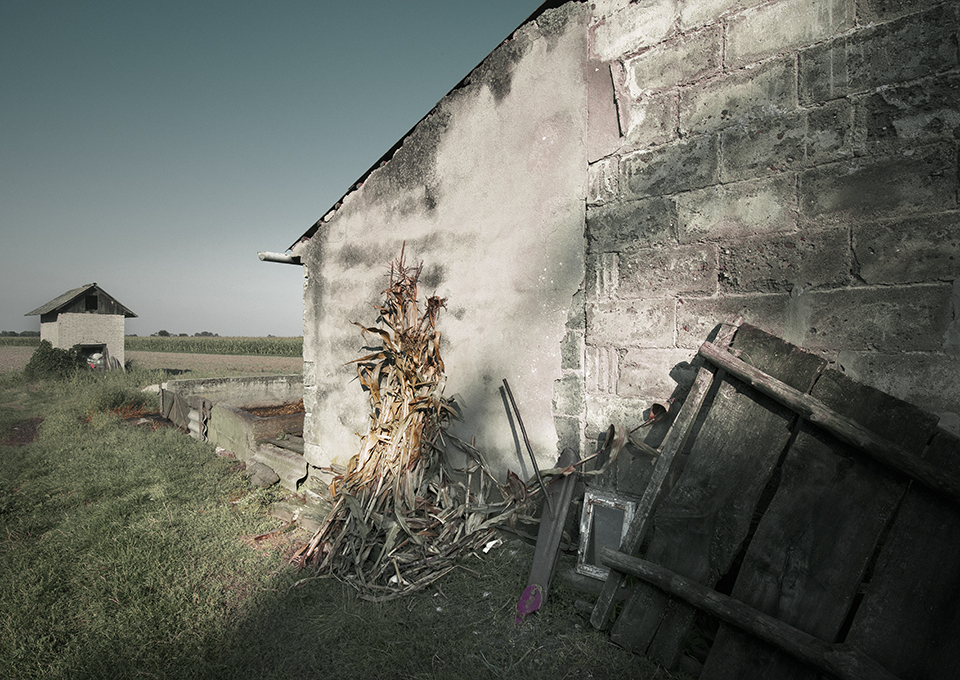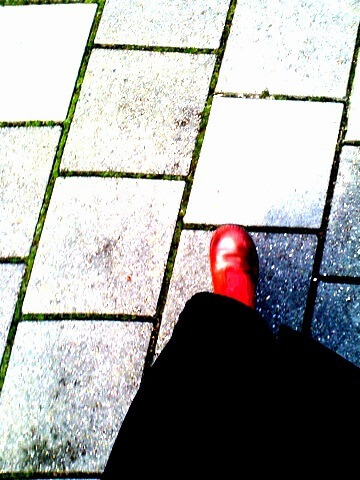There is little left of the rich Jewish history of Tarnow after the Second World War. Yet Tarnow is the city where a remarkable love story begins. Between a Jewish woman and a Catholic man. Imprisoned in Auschwitz, they manage to escape together. They lose each other. And then find each other again, almost 40 years later.
Zalipie
There is no one on the way to Zalipie. Through patches of fog, we drift into an invisible landscape. Cows, their legs erased by the fog, seem to float through the meadows. Rows of pumpkins lie in the fields like stranded buoys.
I try to pronounce the names of the places we pass: Wierzchozlawice, Zbylitowska Gora, but I slip on the jumble of consonants.

Poland
Whoever googles the hamlet of Zalipie – that’s all it is really – stumbles on a picture of a sweet, somehow crooked house. The type of cottage called ‘authentic’ in real estate terms. The white walls and bright blue window frames remind me of North Africa rather than Poland.
But the decorations are those of Eastern Europe: large bouquets of orange and pink flowers cover impetuous white, while garlands of forget-me-nots cover the corners.
Felicja Curytowa
It is Zalipies trademark. Once, the great-grandmother of Felicja Curytowa decided to gloss over the state of her shabby farmhouse to the outside world.
Why she started painting her house, stables, dovecote and doghouse with flowers, is not clear, but suddenly heady bouquets appeared everywhere in the village and over the centuries it has turned into the Zalipie style.
Polish teenager
And that is what we want to see. But the fog and our poor knowledge of Polish make us wander fruitlessly through the fields. To complicate matters further, Zalipie has no center to head for. So the boy on the bicycle is a blessing.
“Hi, we are looking for this house,” I say as I am holding the google image outside the car window. The boy, a beautiful example of the Polish teenager, smiles shyly. “I am terribly sorry but I don’t speak English”, he then replies.
Grandma
We were warned that hardly any German or English was spoken in the southeast of Poland. To our surprise everyone we met, spoke excellent English. However, they all claimed they didn’t. So in the end, the conversations went just as difficult.
Fortunately, the boy is willing to be of help. As he points at the Google image, his eyes gaze on the invisible horizon, “Tam w oddali”, he says. “Somewhere over there in the distance. ”
Museum
Turned out we had already passed it. That we also discover the original house of Felicija, now a museum, is the merit of a another generation. Of a Polish grandma on a bike. Dressed in youthful pink with a matching headscarf she rides into our view. “Come” she gestures, “Follow me.” And so we arrive at the house of Felicja Curytowa.

Felicija is undoubtedly the biggest nightmare of any interior designer. Her love for flowers and her equal fear of white, made her paint floral patterns everywhere: on walls, floors, furniture and ceilings. The interior is a dazzling bouquet in which with difficulty a bed can be distinguished from a sink.
Still dizzy from the abundance of flowers we get in our car. Time to hit Tarnow, a town east of Krakow. Tarnow was once a trading center conveniently located between Krakow and the Ukrainian town Lviv that, in another era, belonged to Poland.
Tarnow
The Tarnowski- family used to rule here. When the city was destroyed by a fire in the 14th century, they had it built back in Renaissance style by Italian architects. The result is that we, centuries later, stand on a beautiful Rynek -market square -in a city that is nicknamed ‘Pearl of the Renaissance.’
Nothing on the beautiful market square, where Polish twentysomethings were sipping espresso’s, reminded of it’s a dark past.
Pope John Paul II
It is, however, not the Pearl of the Renaissance that has lured us to Tarnow, but the Second World War. Since the age of the great fire, the city had a Jewish community which settled on the east side of the market.
Just before the outbreak of the war in 1939, the community consisted of 25,000 people, about 40 percent of the population. After the war, no one is left.
Jewish Tarnow
Pavel is the guide that will show us Jewish Tarnow. But Pavel has a bad day. Without introducing himself he takes us across the square to the cathedral. At the statue of Pope John Paul II, he stops. The beloved Pope is, we will soon discover, the most depicted man in Poland.
The photographer, irritated by his bluntness, grabs his hand and introduces herself. Then she grabs her camera and disappears. Leaving me at the mercy of Pavel’s whims.
Tarnowski dynasty
The guide starts his treatise on the Tarnowski dynastie but I interrupt him. “Pavel listen, I don’t mean to be rude, but I would like to see the remains of the Jewish history of Tarnow.” “Not the church?”, he asks in disbelief. “Everyone wants to see the church. And the statue of the Pope. “Well I don’t”, I reply.
Irritaded Pavel strides to a corner of the square and then into a the street which was inhabited by Jews and would later form the border of the ghetto. Tarnow was the first city in Poland where Jews were required to wear the Jewish star. Between 1942 and 1944 the entire population was killed or deported to the death camps.
Palmyra & Bamiyan
There is little that reminds of the Jewish community. On Synagogue Square only four pillars of the synagogue from the 17th century are left. The rest was destroyed by the Nazis.
When the Afghan Taliban destroyed the Buddhas of Bamiyan in 2001 and recently when IS devastated IS the ancient city of Palmyra, the world was in turmoil.
But the destruction of religious symbols are of all the times I contemplate dreary, while I look at the columns.
“I do not like my work,” says Pavel suddenly as we walk towards the Jewish cemetery. “That’s obvious,” I say. “Why do you do it?” The guide remains silent. Shrugs. “My life is a mess. My whole family immigrated to America. “I want to go too, but my wife does not.”
Jewish cemetery
I hear resentment in his voice. “When my family left, we were just dating. I was in love so I stayed. “And now?” He shrugs again. I do not know if that means that he is no longer in love or that he no longer goes to America.
Georg also has a bad day but that has nothing to do with his wife who is weeding a path at the cemetery. The Jewish cemetery in Tarnow dates from 1580 and is one of the oldest in Poland. And the biggest.
Bulgarian
With his bandana and cigarette I take Georg initially for a Roma, but Georg is a Russian Orthodox Bulgarian who has been hired by the Jewish community to maintain the cemetery.
I do not know what they are paying him, but it cannot be much . The cemetery seems neglected. Georg follows my gaze. “When you are done on one side, you have to start all over again, it’s too big for two people,” he apologizes.
Detainees
“I get help from two detainees but that doesn’t do me any good because those guys are really lazy. The two scheduled for today didn’t show up.” “Didn’t show up? They are prisoners, aren’t they?”, I ask. “Well yes, they rather stayed inside since the weather forecast says it is going to rain.”
“The cemetery was once had a beautiful entrance gate,” says Georg. “No, it is not destroyed by the Nazis. They never knew about the cemetery. Neglect has its advantages, you see. It has been sold or given away, I don’t recall, to the Washington Memorial Museum.”
Star of David
I walk back to town with Pavel for the last and most gruesome relic. Besides having the dubious honor of being the first city that forced the Star of David upon its Jewish citizens, Tarnow has another first to its name:

Auschwitz
It is the city from where the first transport to Auschwitz departed on June 14, 1940. Incidentally, it were not Jews but political prisoners who had been imprisoned in the Jewish bath, the mikvah.
The bathhouse in Moorish style is still there, but the accommodation of a number of danceclubs in the building has completely ruined it. Opposite, on the Square of Auschwitz Prisoners, stands a memorial to the first 728 people who were transported Auschwitz.
Jerzy Bielecki
One of them was the German speaking Jerzy Bielecki, a 19-year-old boy who was arrested in 1940 as he was on his way to join the Polish army. The Nazis suspected him to be part of the resistance.
Shakespeare’s tragedy of Romeo and Juliet’s fades in the light of this young man’s story. Happiness, love and misfortune, all staged in Auschwitz. Jerzy had managed to survive for some years when in 1943, he meets the Jewish Cyla Cybulska, who was detained in Auschwitz II.
Escape from Auschwitz
Although men and women were not allowed to talk to each other, he finds enough excuses to exchange a few words with her on a regular basis. They fall in love and Jerzy starts preparing for an escape.
In a stolen SS-uniform he manages to escape on June 21, 1944 with Cyla. he takes her to a farmhouse in the village of his family. He leaves for Krakow, where he wants to join the resistence.
Soviets
As the Soviets roll into Krakow on January 1945, Jerzy walks thirty kilometers through the snow back to the farm. To reunite with Cyla. But he is too late. Cyla, tired of waiting, had given up hope of ever seeing him again. She thinks he’s dead, or has left her.
Just a few days before his arrival, she had taken the train to Warsaw. In the train she meets a man. With him she moves eventually to New York. She learns that Jerzy has been killed in the war.
Polish television
Jerzy hears later that she left the country and died in Sweden. So that was that. Thirty nine years they both live under the assumption that the other has died.
Until … May 1983 wheb Cyla tells her story to her Polish cleaning lady. The cleaning lady is surprised because she has heard this story before. On a Polish tv-channel to be exact. Narrated by Jerzy.
I try to imagine what must Cyla must have thought or felt when she learned he was still alive.

Auschwitz memorial
Now she knows that he is alive, Cyla is determined to track him down. Thirty nine years later she has found him and flies to Poland where Jerzy is waiting for her with 39 roses. Together they visit the Auschwitz memorial and for a few years they regularly visit each other.
Rynek
Walking back from the memorial to the Rynek, I ask Pavel what kind of work he would like to do. “Fireman!” Fireman? I honestly have never heard of men in their forties wanting to join the fire brigades. “Well you can still go for it,” I say.
“No,” he says angrily. “Now it’s too late. My life is over.”
“It’s never too late,” I say, thinking of Jerzy and Cyla.
Text: Anneke de Bundel – Images: Nicole Franken
This story is translated from Dutch


